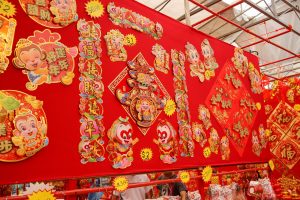Complicating raciolinguistics: Language, Chineseness, and the Sinophone
February 1, 2022

Chinese New Year, which falls on February 1 in 2022, is also known as the Spring Festival or Lunar New Year. It is the most important festival to Chinese people, and celebrates the beginning of a new year on the traditional lunisolar Chinese calendar.
‘Chinese’ is often used interchangeably as designations of race, ethnicity, and nationality. Given that these three axes of identification are intertwined, we cannot fully understand any one of them without taking into account the other two.
In ‘Complicating raciolinguistics: Language, Chineseness, and the Sinophone’ (Language & Communication, 2021) Professor Andrew D. Wong (California State University Department of Anthropology, Geography & Environmental Studies), Professor Su Hsi-Yao (National Taiwan Normal University Department of English), and Associate Professor Mie Hiramoto (NUS Department of English Language and Literature) explore the contested notion of Chineseness by examining six different ethnographic cases. Through this investigation, they shed light on how language mediates the relationship between race, ethnicity, and nationality.
China was originally conceived as a multi-ethnic state. However, rather than serving as a descriptor of nationality, the label ‘Chinese’ is more often associated with Han-ness and excludes ethnic minorities living in China like the Manchus and Tibetans. Furthermore, the ‘Han’ group encompasses a broad range of cultures, languages, and ethnicities, leading to further complication of the definition of ‘Chinese’.
The ‘Sinophone’ refers to a loosely connected network of Sinitic-language communities outside China as well as ethnic minority communities within China where Mandarin is adopted or imposed. These include people in Tibet, Taiwan, and Hong Kong, as well as ethnic Chinese communities in the US and Southeast Asia. People in Sinophone communities, despite different experiences in their respective countries, are bound together by a shared history of Han Chinese colonialism and migration, and all bear historically contested relationships to Chineseness and China.
In Taiwan and Hong Kong, the Han Chinese populations are the majority. However, younger generations choose to identify as Taiwanese rather than Chinese to show their appreciation for the Taiwanese way of life and reject any potential Communist rule. Similarly, in Hong Kong, ‘Chinese’ and ‘Hongkonger’ are seen by many as mutually exclusive rather than complementary. Cantonese is also depicted as more authentically ‘Chinese’ than Putonghua, the standard form of Mandarin spoken in Beijing. Cantonese speakers are therefore depicted as the ‘true guardians of Chinese culture’.
Chineseness also takes on different forms when people use it as a tool to define themselves in relation to others. In Singapore, the term ‘Chinese’ tends to function as a designation of race. Being Chinese is an inescapable fact of life regardless of whether or not they identify themselves as such. However, Chinese Singaporeans highlight their national identity and resist being aligned with Mainland Mandarin speakers from China by consciously adopting English-Mandarin bilingual practices and avoiding certain standard linguistic Mandarin features common in China.
Read the article here.
